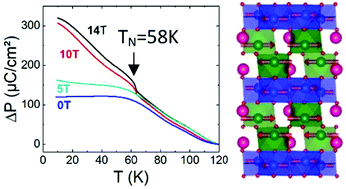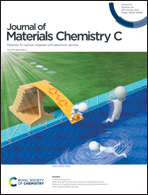Fe2Co2Nb2O9: a magnetoelectric honeycomb antiferromagnet†
Abstract
Fe4Nb2O9 and Co4Nb2O9 are antiferromagnetic compounds belonging to the M4M′2O9 series (M = Mn, Fe, Co; M′ = Nb, Ta), whose structure (P![[3 with combining macron]](https://www.rsc.org/images/entities/char_0033_0304.gif) c1) derives from the Cr2O3 corundum one. By mixing cobalt and iron in a 1 : 1 ratio, an Fe2Co2Nb2O9 oxide has been synthesized. Its structural, magnetic and electric characterization studies confirm that its unit cell volume (V = 331.19(1) Å3), Néel temperature (TN = 58 K) and dielectric permittivity are intermediate between those of the Fe4Nb2O9 and Co4Nb2O9 end members. The neutron diffraction study evidences an Fe:Co random occupation of the (4d) Wyckoff sites. Its antiferromagnetic structure, refined in the C2/c′ magnetic space group, shows magnetic moments in the planes of the honeycomb (HC) layers of the M4M′2O9 structure, and stacked along c, as for Fe4Nb2O9 and Co4Nb2O9. However, the magnetic field induced magnetization M(H) of Fe2Co2Nb2O9 below TN differs strongly from both end members, exhibiting a sublinear dependence. A similar rounded shape of the electric polarization P(H) curve is evidenced, in marked contrast to the linear M(H) and P(H) behaviours observed below the spin-flop magnetic field for this class of linear magnetoelectric materials. As a result, Fe2Co2Nb2O9 exhibits larger P values and steeper P responses to H at low H than both Fe4Nb2O9 and Co4Nb2O9 end members. This result is explained by a microscopic model based on the Fe and Co mixed occupation. Substitutional disorder locally allows for stronger magnetoelectric couplings and its effect does not cancel on average. This chemical substitution effect opens a new route to enhance the magnetoelectric response of honeycomb antiferromagnets.
c1) derives from the Cr2O3 corundum one. By mixing cobalt and iron in a 1 : 1 ratio, an Fe2Co2Nb2O9 oxide has been synthesized. Its structural, magnetic and electric characterization studies confirm that its unit cell volume (V = 331.19(1) Å3), Néel temperature (TN = 58 K) and dielectric permittivity are intermediate between those of the Fe4Nb2O9 and Co4Nb2O9 end members. The neutron diffraction study evidences an Fe:Co random occupation of the (4d) Wyckoff sites. Its antiferromagnetic structure, refined in the C2/c′ magnetic space group, shows magnetic moments in the planes of the honeycomb (HC) layers of the M4M′2O9 structure, and stacked along c, as for Fe4Nb2O9 and Co4Nb2O9. However, the magnetic field induced magnetization M(H) of Fe2Co2Nb2O9 below TN differs strongly from both end members, exhibiting a sublinear dependence. A similar rounded shape of the electric polarization P(H) curve is evidenced, in marked contrast to the linear M(H) and P(H) behaviours observed below the spin-flop magnetic field for this class of linear magnetoelectric materials. As a result, Fe2Co2Nb2O9 exhibits larger P values and steeper P responses to H at low H than both Fe4Nb2O9 and Co4Nb2O9 end members. This result is explained by a microscopic model based on the Fe and Co mixed occupation. Substitutional disorder locally allows for stronger magnetoelectric couplings and its effect does not cancel on average. This chemical substitution effect opens a new route to enhance the magnetoelectric response of honeycomb antiferromagnets.



 Please wait while we load your content...
Please wait while we load your content...